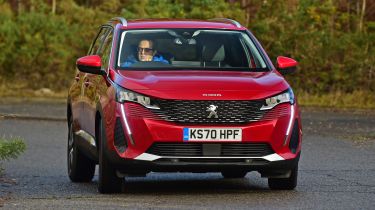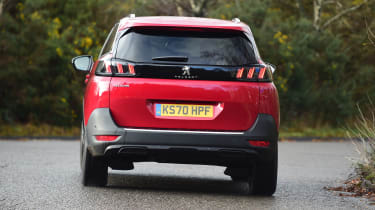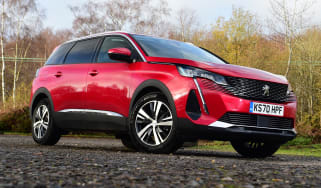Peugeot 5008 SUV - Engines, drive & performance (2017-2024)
If you’re after relaxing journeys, the Peugeot 5008 is a good car to drive
For a relatively large SUV, the way the Peugeot 5008 handles is impressive. In fact, it feels better to drive than most large MPVs, and only a few SUV rivals like the Skoda Kodiaq offer a slightly sharper drive.
Now automatic-only, early versions were available with a manual gearbox. The latter is smooth enough, but the gearlever feels quite big in the hand. The auto that is now standard across the range can be a bit jerky at low speeds but it’s slicker the faster you go, and we're yet to try the new six-speed automatic.
A common conversation topic when talking about modern Peugeot's is the small steering wheel. While it makes the 5008 easy to manoeuvre in tight streets, it feels a bit strange in such a big SUV. Further to this, some drivers may find the top of the wheel obscures the i-Cockpit instrument cluster, which isn’t ideal. We’d advise you to try before you buy.
But as a 5008’s driver only makes up 14.2 per cent of its potential occupants, Peugeot’s strategy to prioritise comfort over thrills makes a great deal of sense. It’s been executed successfully and is likely to be welcomed by passengers.
The 5008 is quiet and settled at motorway speeds, with the suspension insulating you expertly from such trifles as cat’s eyes and lane demarcations. On smaller, rougher roads it’s even more impressive, with big bumps and prominent potholes being absorbed with maximum efficacy and minimal fuss.
Peugeot 5008 petrol engines
The 5008’s engines are familiar from the rest of Peugeot’s range and changes in early 2023 brought an updated version of its 1.2-litre petrol with mild-hybrid technology which boosts power to 134bhp.
More reviews
We’ve not yet driven a 5008 fitted with this engine, but we expect the differences to be minimal; Peugeot says it’s possible to “start, manoeuvre and drive at low speed in heavy traffic in 100% electric mode” but chances are this will only be for very short bursts. In our experience, mild-hybrid technology has a greater effect on fuel efficiency than performance.
However, the 1.2-litre 5008 is impressively light – weighing little more than some family hatchbacks – so it matched the more powerful Skoda Kodiaq during most of our in-gear acceleration tests. Despite being smaller, it also feels more flexible and refined than the old Nissan X-Trail’s 1.6-litre petrol engine.
Previously, Peugeot also offered a more powerful 178bhp 1.6-litre engine in the 5008. If you’re regularly travelling with a full load, it might be worth seeking out one of these on the secondhand market.
Diesel engines
Gone are the days when the majority of SUV buyers pick diesel over petrol. As such, there’s just one diesel option available to 5008 buyers: a 1.5-litre BlueHDi with 128bhp. While that might not sound like much, the improved torque versus the petrol makes it feel less laboured when accelerating. It’s not fast, but nor does it need to be; refinement is strong, with just a distant hum as you drive along.
Like with the petrol line-up, Peugeot previously offered a more powerful diesel. With 175bhp, the 2.0-litre was reasonably quick, getting from 0-62mph in 9.2 seconds. It’s no surprise it was discontinued though; most buyers chose a version lower down the 5008 range.














